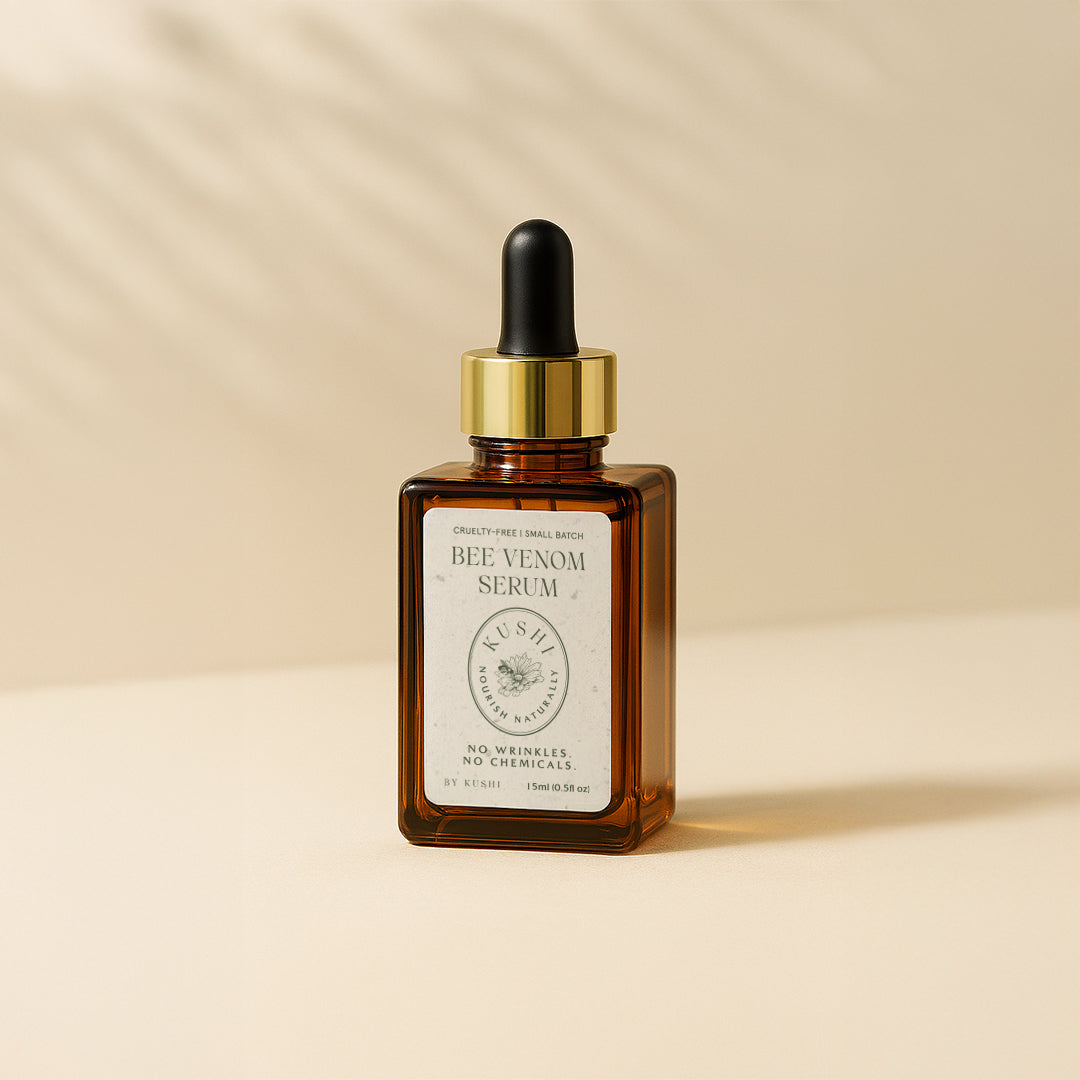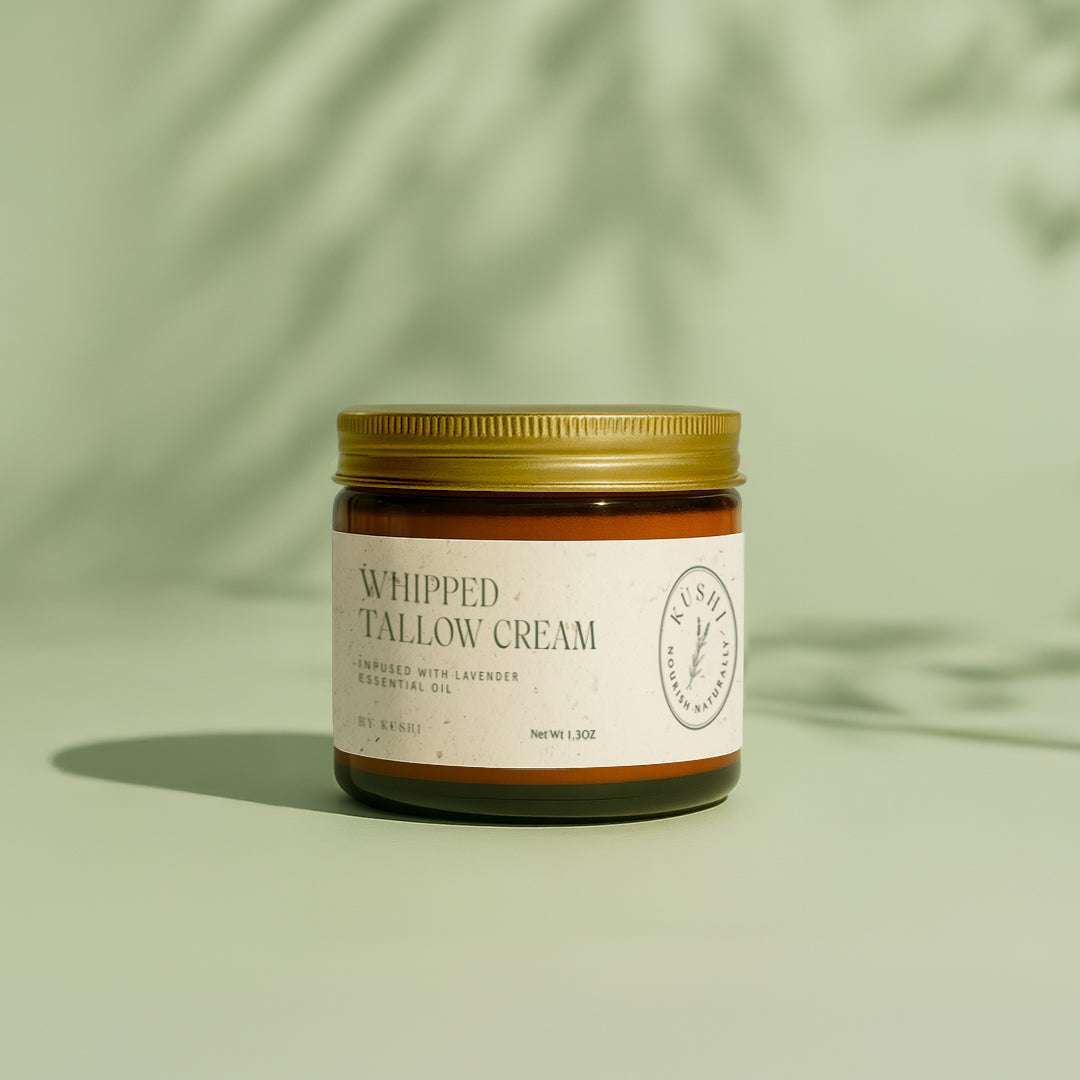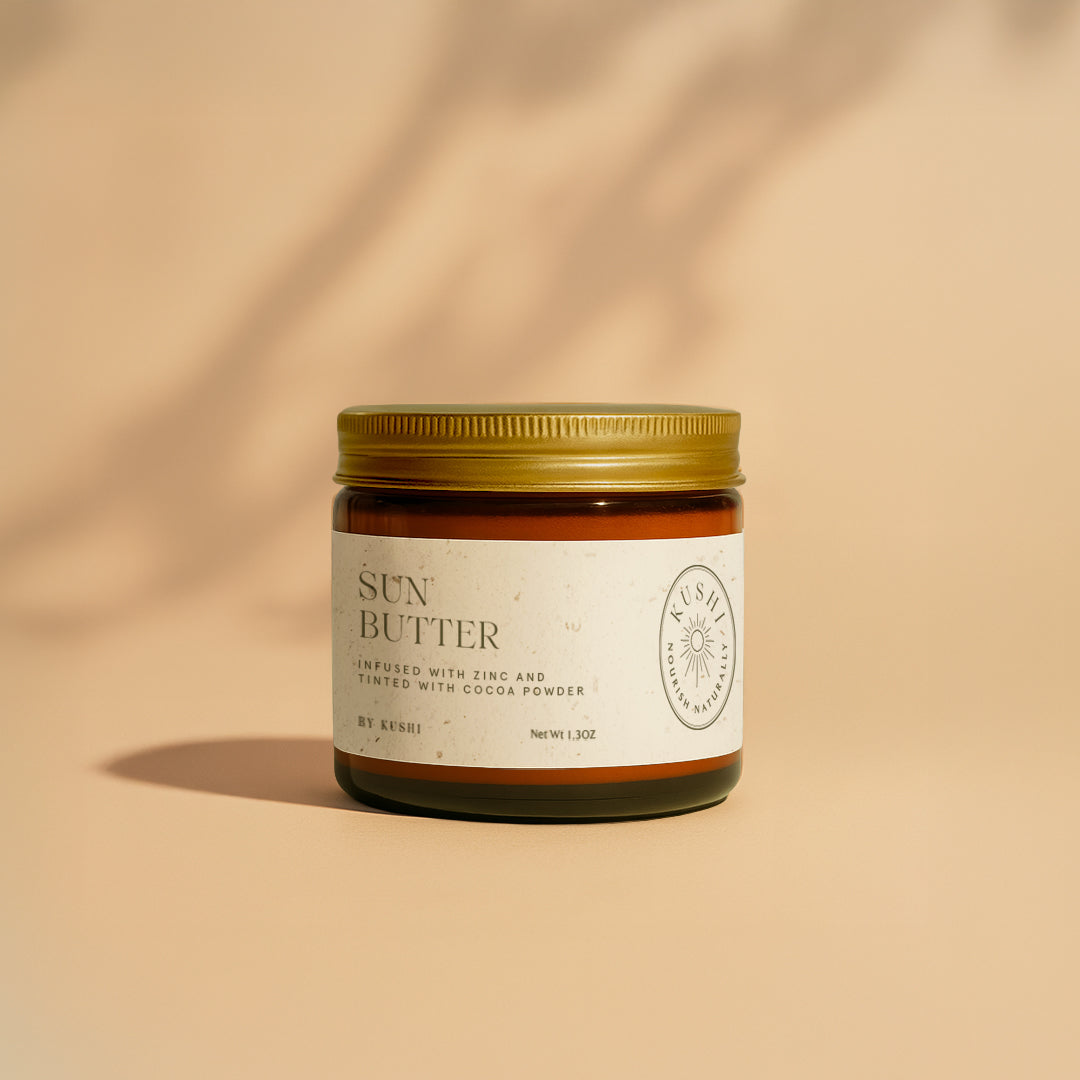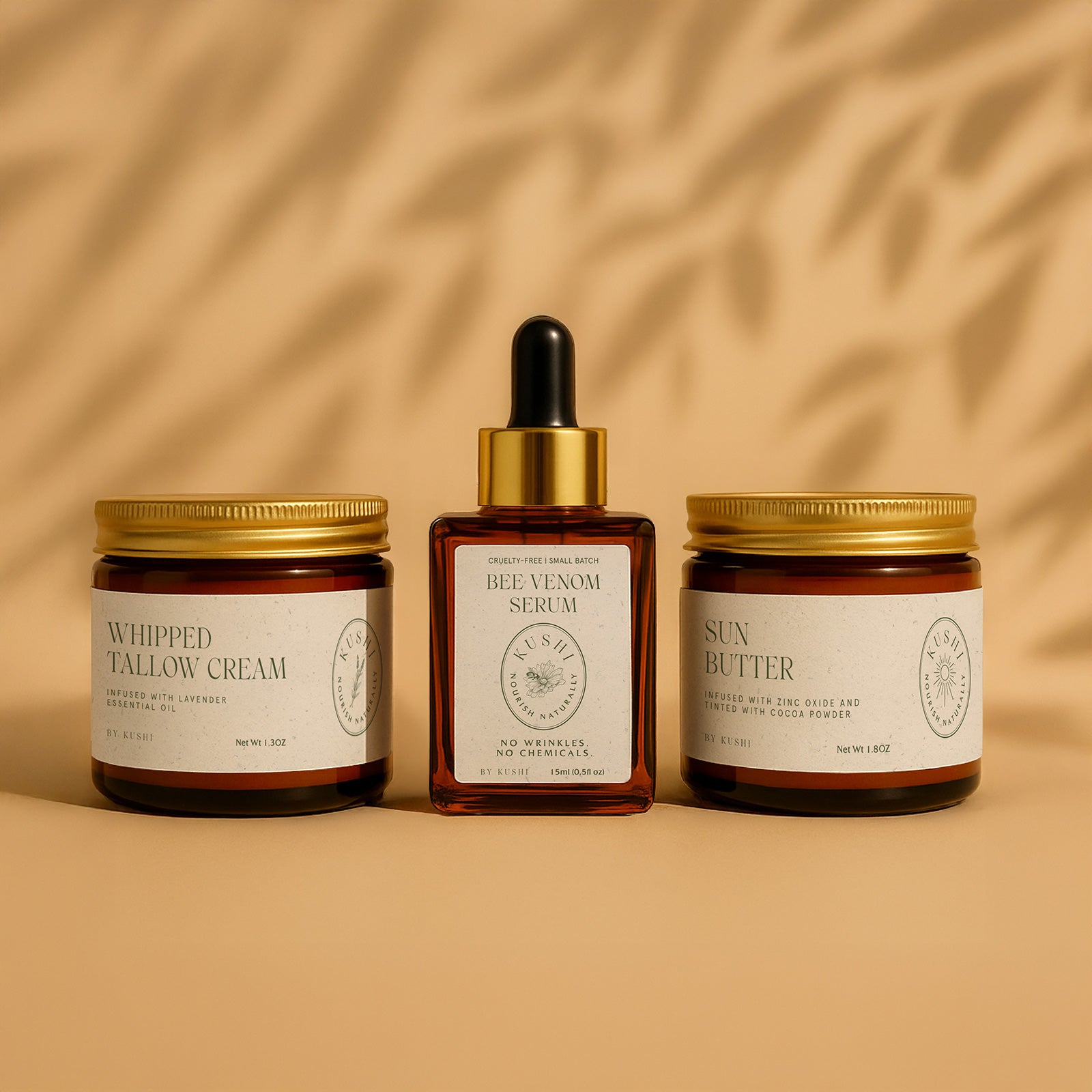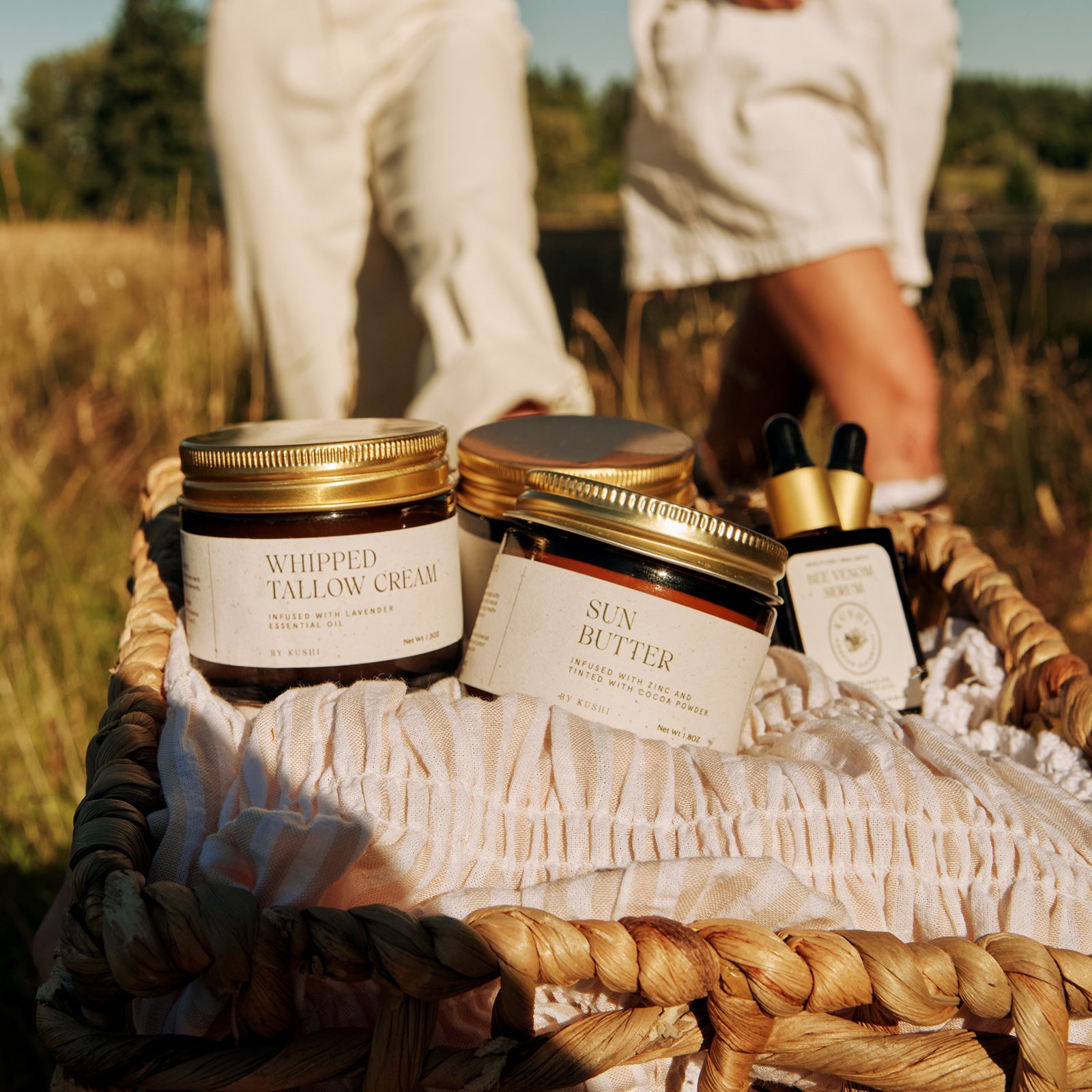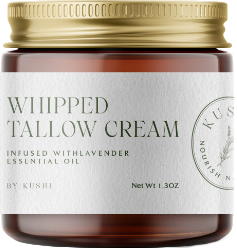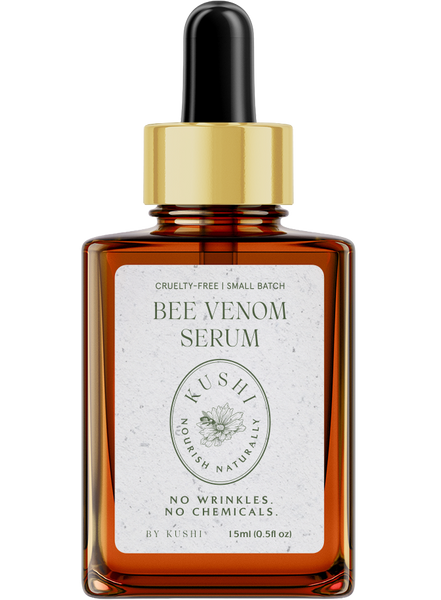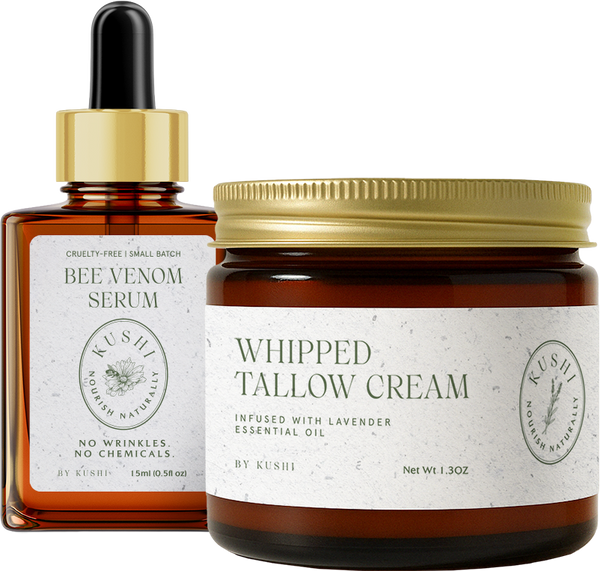Key Takeaways:
-
Bioavailability & Skin Compatibility: Tallow closely matches human sebum, making it ideal for quick absorption and deep nourishment. Shea butter hydrates more slowly and has a thicker feel.
-
Source & Sustainability: Tallow supports regenerative farming and reduces waste; shea butter is ethically wild-harvested, often by women-led cooperatives in Africa.
-
Use Cases Vary: Tallow is best for sensitive, acne-prone, or compromised skin, while shea butter excels in dry, flaky areas and plant-based skincare routines.
Looking at your ingredient label, how often do you recognize every item? For those who value purity in what goes on their skin, the rise of traditional moisturizers like tallow and shea butter offers more than a trend—it offers trust. These aren’t lab-born solutions. They’re earth-given, time-proven remedies that support the skin as nature intended.
At Kushi, we don’t believe in complicated skincare. We craft small-batch, grass-fed Whipped Tallow Cream using only what’s necessary—no synthetics, no fillers. Just nutrient-dense ingredients rooted in generations of wisdom and backed by a deep respect for skin integrity.
In this piece, we’ll explore the comparison of tallow vs shea butter—examining their origins, skin benefits, uses, and how to choose the right option for your natural skincare ritual.
What Is Tallow?
Tallow is rendered animal fat, most commonly from grass-fed beef, and has been used for centuries as a skin salve and protector. When prepared properly, especially from grass-fed and finished sources, it becomes a deeply nourishing fat rich in vitamins A, D, E, and K. These fat-soluble nutrients are essential for skin repair, moisture retention, and overall barrier support.
What sets tallow apart is how closely it mimics the natural oils our skin produces. Its lipid profile is nearly identical to human sebum, making it highly bioavailable and readily absorbed without clogging pores or disrupting the skin’s natural balance.
At Kushi, our Whipped Tallow Cream is made in small batches using only two ingredients: 100% grass-fed, finished beef tallow and certified organic lavender essential oil. It’s a simple formulation, but incredibly effective for those dealing with eczema, psoriasis, acne, or dry, reactive skin.
What Is Shea Butter?
Shea butter is a creamy fat extracted from the nuts of the shea tree, native to West Africa. For generations, it has served as a staple in traditional skincare, used to soothe, soften, and protect the skin from environmental stressors. Unrefined shea butter retains its natural ivory color, earthy scent, and full range of skin-loving nutrients.
It’s rich in fatty acids like oleic, stearic, and linoleic acid, which help restore moisture and reinforce the skin’s barrier. Shea butter also contains vitamins A and E, which support skin regeneration and calm inflammation.
While not identical to human sebum like tallow, shea butter delivers deep hydration and is especially well-suited for dry, flaky skin. Its soft, buttery consistency makes it easy to blend into balms, body butters, and facial creams, especially for those seeking a plant-based option.
Nutrient Profile: Tallow Vs Shea Butter
When choosing a natural moisturizer, understanding its nutritional composition is essential. The skin responds best to ingredients rich in bioavailable nutrients, and tallow and shea butter bring unique strengths to the table. Here's how they compare across key components:
Vitamins A, D, E, And K In Tallow
Tallow naturally contains all four fat-soluble vitamins: A, D, E, and K. These support skin regeneration, boost collagen production, and promote healing from dryness, inflammation, and sun damage. The presence of vitamin K, in particular, makes tallow unique—it helps reduce redness and improve skin elasticity.
Fatty Acids In Shea Butter
Shea butter is rich in oleic, stearic, palmitic, and linoleic acids, vital for maintaining a healthy skin barrier. These fatty acids deeply moisturize the skin while helping to reduce flakiness and irritation. They also create a breathable protective layer, sealing in hydration without clogging pores.
Bioavailability And Absorption
Tallow closely matches the lipid profile of human sebum, making it highly bioavailable and easily absorbed. This means it doesn’t just sit on the surface; it penetrates, nourishes, and supports the skin’s deeper layers. Shea butter, though effective, has a slightly heavier feel and may take longer to absorb, especially in cooler environments.
Antioxidants And Skin Defense
Shea butter contains natural antioxidants, including vitamin E and cinnamic acid esters, which help neutralize free radicals. These compounds protect the skin from environmental stress and premature aging. While tallow also contains antioxidants, its strength lies more in replenishing essential skin nutrients than environmental defense.
How Tallow And Shea Butter Support Skin Health
Moisturizers should do more than sit on the surface—they should work with the skin to heal, protect, and restore. In the comparison of tallow vs shea butter, both deliver nourishing benefits, but their therapeutic qualities differ slightly. Let’s look at how each supports skin health in its own way:
Skin Barrier Repair
Tallow contains nutrients and lipids that closely mirror the skin’s natural composition. This makes it especially effective at restoring a damaged or weakened barrier, sealing in moisture while allowing the skin to breathe. It’s ideal for people experiencing chronic dryness or skin conditions like eczema or rosacea.
Moisture Retention
Shea butter shines when it comes to holding moisture in the skin. Its rich fatty acid content creates a soft, breathable layer that prevents water loss and keeps skin feeling supple. This makes it a go-to for dry climates or anyone prone to flaky or tight skin.
Anti-Inflammatory Properties
Both tallow and shea butter have natural anti-inflammatory compounds, but they act in slightly different ways. Tallow’s vitamins A and D support deep cellular healing, while shea butter contains compounds like lupeol and cinnamic acid that calm irritation at the surface. Either can help reduce redness and discomfort, especially when used consistently.
Support For Sensitive Skin
Tallow’s bioavailability and minimal formulation make it well-suited for sensitive or allergy-prone skin. It absorbs quickly, with fewer reactions than many plant-based oils. Shea butter is generally gentle as well, but due to its origin from the shea nut, those with nut sensitivities may need to patch test first.
Best Uses For Tallow And Shea Butter
Both tallow and shea butter are deeply nourishing, but their texture, absorption, and nutrient profiles lend themselves to slightly different uses. One may be better suited for certain applications depending on your skin type and needs. Here’s how they perform in real-world skincare routines:
Everyday Facial Moisturizer
Tallow’s fast absorption and skin-compatible structure make it an excellent choice for daily facial moisturizing. It doesn’t leave a greasy residue and works well under makeup or sunscreen. Its simplicity can help reduce irritation for those with acne-prone or reactive skin.
Body Butter And Deep Hydration
Shea butter is ideal for full-body applications, especially in dry areas like elbows, knees, and feet. Its thicker consistency creates a soft, lasting barrier that protects the skin throughout the day. It’s particularly helpful when skin loses moisture quickly during cold, dry seasons.
Targeted Healing For Skin Conditions
Tallow is often used to soothe conditions like eczema, psoriasis, and dermatitis because of its high vitamin content and anti-inflammatory properties. It helps reduce flare-ups and supports long-term healing. Its purity and lack of synthetics make it a safe choice for compromised skin.
Post-Shave Or Post-Sun Care
Shea butter’s calming effect makes it well-suited for soothing skin after shaving or sun exposure. Its anti-inflammatory and emollient properties help reduce irritation and redness. When applied in a thin layer, shea butter leaves the skin soft, smooth, and protected.
Sustainability And Sourcing
For many who care about what goes on their skin, how an ingredient is sourced matters as much as how it performs. Ethical harvesting, regenerative practices, and local partnerships all play a role in the integrity of a skincare product. Here’s how tallow vs shea butter compares in terms of sustainability:
Tallow: Regenerative And Local
Tallow, especially when sourced from grass-fed, pasture-raised cattle, supports regenerative agriculture and reduces waste by utilizing every part of the animal. At Kushi, our tallow is sourced from small Canadian family farms that practice ethical, sustainable livestock care. This minimizes environmental impact and supports local food systems and ancestral crafts.
Shea Butter: Community-Driven And Wild-Harvested
Shea butter is traditionally harvested by women in West African communities, often through cooperatives that support fair wages and rural economies. The nuts are collected from wild shea trees, meaning the process does not rely on deforestation or monoculture farming. However, long transport distances and growing demand raise questions about carbon footprint and large-scale supply chain ethics.
Minimal Processing And Clean Extraction
Both tallow and unrefined shea butter require very little processing, which keeps their natural nutrients intact. Tallow is simply rendered from fat, while shea butter is extracted from crushed nuts and whipped into a smooth butter. This simplicity ensures fewer additives, less energy use, and a final product that remains close to nature.
Final Thoughts
Choosing between tallow vs shea butter isn’t about which is better; it’s about what your skin needs, and what values matter to you. Both are deeply nourishing, rich in nutrients, and grounded in natural tradition. The difference lies in how they interact with your skin, environment, and sense of ritual.
Tallow offers unmatched bioavailability and is ideal for sensitive, reactive, or compromised skin. Shea butter provides soft, lasting hydration and aligns well with plant-based preferences. Either one can be the foundation of a simplified, non-toxic skincare routine.
Whichever path you choose, the key is clarity—knowing your ingredients, trusting their origin, and listening to your skin. Natural care is never one-size-fits-all, but with tallow and shea butter, you choose time-honored tools that work with your skin, not against it.
Read also:
Frequently Asked Questions About Tallow Vs Shea Butter
Is tallow suitable for oily skin types?
Yes, tallow can actually help regulate oil production because it is similar to human sebum. It provides nourishment without overwhelming the skin. Many with oily or combination skin find it balances rather than clogs.
Can shea butter be used on the scalp or hair?
Shea butter is often used as a deep-conditioning treatment for dry or damaged hair. It can soothe a dry scalp and soften curls or coarse textures. However, it should be used sparingly to avoid buildup.
How do I store tallow-based skincare products?
Store tallow products in a cool, dry place away from direct sunlight. Because it’s a stable fat, it doesn’t spoil easily, but temperature changes can affect texture. Always use clean fingers or a spatula to preserve freshness.
Is shea butter affected by heat or cold?
Yes, shea butter can become grainy if it melts and resolidifies too quickly. This doesn’t affect its quality but can alter its texture. Gently warming it and re-whipping can restore its smoothness.
Can tallow be used around the eyes?
Yes, tallow can be safely applied to the delicate skin around the eyes. Its gentle, non-irritating nature makes it a good natural alternative to synthetic eye creams. Just use a minimal amount and pat it in gently.
What’s the texture difference between tallow and shea butter?
Tallow has a lighter, whipped texture that melts on contact with skin. Shea butter is thicker, more solid, and takes longer to soften. Tallow absorbs quickly, while shea tends to linger on the surface longer.
Are both ingredients suitable for minimalist skincare routines?
Absolutely—both tallow and shea butter are perfect for those who prefer simple, whole-ingredient routines. They eliminate the need for multiple synthetic products. Each can be used solo or as a base for DIY blends.
Which is better for nighttime skincare, tallow or shea butter?
Shea butter’s heavier texture makes it ideal for overnight use when the skin slowly absorbs moisture. Tallow, though lighter, still supports overnight repair without feeling greasy. It comes down to how much moisture your skin craves at night.
Can tallow or shea butter help with skin texture issues?
Yes, both can help improve skin texture when used regularly. Tallow promotes smoother skin by nourishing deeply and supporting regeneration. Shea butter helps soften rough areas and even dry patches over time.
Are either of them suitable for post-tattoo care?
Tallow is often favored for post-tattoo care due to its simplicity and nutrient-rich profile that supports healing. Shea butter can also soothe and moisturize healing skin, but make sure it’s unrefined and fragrance-free. Always follow your tattoo artist’s aftercare advice.
